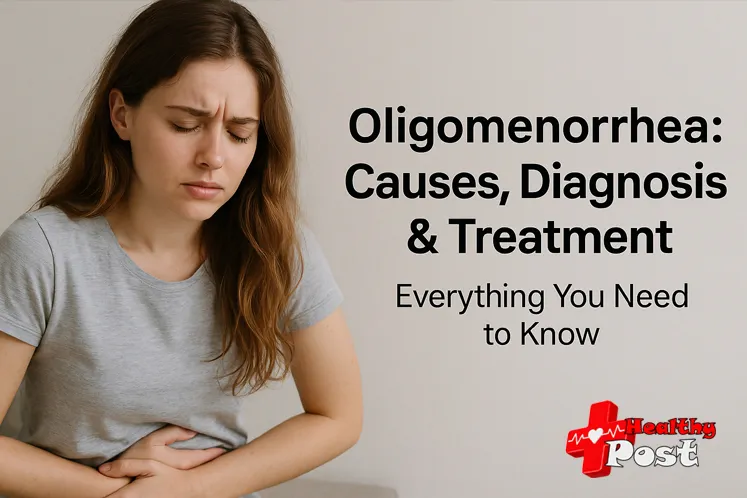
Oligomenorrhea: Causes, Diagnosis and Treatment
Unfortunately, for some women, it can be anything but kind! We will talk about them today!
Oligomenorrhea (hereinafter AM) is painful menstruation that turns a woman’s life into hell once a month.
There are primary and secondary Oligomenorrhea.
- Primary AM occurs without structural changes in the genitals.
- Secondary AM – against the background of various pathologies.
Causes of development of primary Oligomenorrhea:
- Increased contractions of the uterine muscles caused by a violation of prostaglandin synthesis. The cause of the violation is a deficiency of PUFA, iron, magnesium, vitamin D, an imbalance of estrogens and progesterone!
- Lability of the nervous system with a decrease in the combat threshold. Cause: disruption of vasopressin production.
- Difficulty in the outflow of menstrual blood from the uterus (incorrect position of the uterus) Cause: deficiencies of vitamin D, PUFAs in the mother during pregnancy and during the period of growth and development of the girl.
- Hypoplasia of the uterus in infantilism. Insufficient development of muscle elements that are difficult to stretch during menstrual plethora, resulting in irritation of nerve endings, their hypoxia and pain. Cause: lack of estrogen, vitamin D, iron, magnesium during the period of development of the girl.
Causes of secondary Oligomenorrhea:
- genital endometriosis.
- chronic inflammation, adhesions and disruption of the position of the uterus in the pelvis, adhesions (synechiae) in the uterine cavity after interventions or inflammation.
- IUD (spiral).
- After traumatic births and abortions, ruptures of the posterior leaflet of the broad ligament and varicose veins of the pelvic veins at the base of the broad ligament of the uterus occur, which leads to Oligomenorrhea.
- anomalies in the development of the genital organs: rudimentary horn of the uterus, duplication of the uterus, atresia of the cervical canal.
I think we won’t go into detail about the clinic. I’ll just say that in 10-15% of women, the intensity of pain and accompanying vegetative disorders leads to complete loss of working capacity for several days.
Diagnostics and treatment of primary and secondary Oligomenorrhea have some differences, which we’ll discuss in detail below.
How can a doctor understand the intensity of pain in Oligomenorrhea, since everyone has their own pain threshold? There are special scales for this.
The degree of Oligomenorrhea is determined by the combination of pain and accompanying vegetative disorders: nausea, dizziness, heartburn, chills, fever, tachycardia or bradycardia, tenesmus, bloating and the need to use pain killers. We begin the examination with:
Examination
- Anamnesis of life and disease. We find out whether the form of Oligomenorrhea is primary or secondary.
- General examination, bioimpedance and dynamometry to assess muscle mass and strength.
- We are looking for deficiencies: vitD, iron, magnesium, omega 3. Important! Blood biochemistry, liver enzymes, glucose.
- Gynecological examination.
- Ultrasound (to exclude adenomyosis, developmental abnormalities of the uterus and vagina).
- Let’s explore the level:
- progesterone – before menstruation it triggers the synthesis of prostaglandins;
- estrogens – essential;
- prostaglandins – strong The higher their level in the endometrium, the more severe the Oligomenorrhea;
- vasopressin – in women with Oligomenorrhea, which leads to prostaglandins (especially PgF2α levels) and increased contractile activity of the uterus.
- Hysteroscopy (to exclude internal endometriosis and submucous myomatous nodes).
- Laparoscopy (to exclude external endometriosis, pelvic vein dilation, ruptures of the broad ligaments.
- It is possible to perform a pipelle biopsy of the endometrium with immunohistochemical analysis of the endometrium.
The last 3 points are invasive and are rarely used in women who have not given birth.
Treatment of secondary OM consists of eliminating the underlying disease.
But there are differences of opinion regarding the treatment of primary Oligomenorrhea.
The classic doctor’s prescription is:
- Micronized progesterone in phase 2 (I agree, but not first and foremost).
- COC (absolutely not).
- NSAIDs (I have mixed feelings about this, but I will prescribe them at the beginning of treatment to relieve pain – I always feel sorry for them).
What I find of primary importance:
- replenish deficiencies, especially magnesium, iron and PUFAs.
- provide muscle cells with oxygen (iron, vitamin D, antioxidants).
- Normalize estrogen/progesterone.
- Remember about vasopressin? Sleep, nutrition, massage, relaxation, walks – everything is great!

